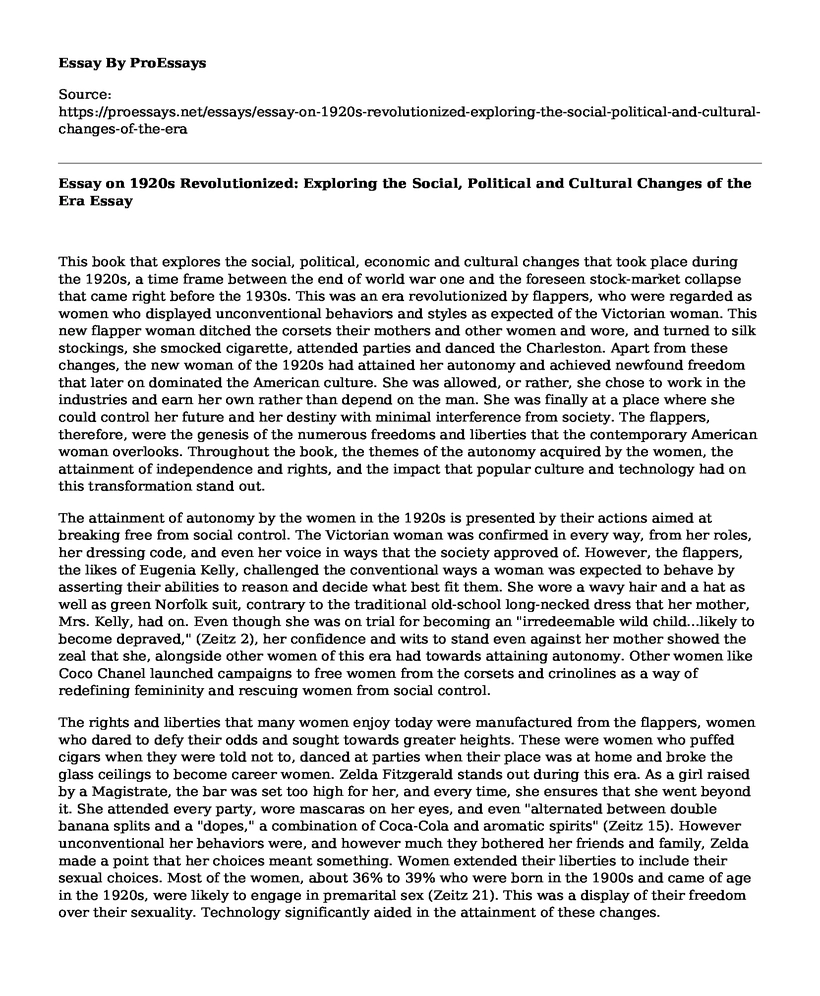This book that explores the social, political, economic and cultural changes that took place during the 1920s, a time frame between the end of world war one and the foreseen stock-market collapse that came right before the 1930s. This was an era revolutionized by flappers, who were regarded as women who displayed unconventional behaviors and styles as expected of the Victorian woman. This new flapper woman ditched the corsets their mothers and other women and wore, and turned to silk stockings, she smocked cigarette, attended parties and danced the Charleston. Apart from these changes, the new woman of the 1920s had attained her autonomy and achieved newfound freedom that later on dominated the American culture. She was allowed, or rather, she chose to work in the industries and earn her own rather than depend on the man. She was finally at a place where she could control her future and her destiny with minimal interference from society. The flappers, therefore, were the genesis of the numerous freedoms and liberties that the contemporary American woman overlooks. Throughout the book, the themes of the autonomy acquired by the women, the attainment of independence and rights, and the impact that popular culture and technology had on this transformation stand out.
The attainment of autonomy by the women in the 1920s is presented by their actions aimed at breaking free from social control. The Victorian woman was confirmed in every way, from her roles, her dressing code, and even her voice in ways that the society approved of. However, the flappers, the likes of Eugenia Kelly, challenged the conventional ways a woman was expected to behave by asserting their abilities to reason and decide what best fit them. She wore a wavy hair and a hat as well as green Norfolk suit, contrary to the traditional old-school long-necked dress that her mother, Mrs. Kelly, had on. Even though she was on trial for becoming an "irredeemable wild child...likely to become depraved," (Zeitz 2), her confidence and wits to stand even against her mother showed the zeal that she, alongside other women of this era had towards attaining autonomy. Other women like Coco Chanel launched campaigns to free women from the corsets and crinolines as a way of redefining femininity and rescuing women from social control.
The rights and liberties that many women enjoy today were manufactured from the flappers, women who dared to defy their odds and sought towards greater heights. These were women who puffed cigars when they were told not to, danced at parties when their place was at home and broke the glass ceilings to become career women. Zelda Fitzgerald stands out during this era. As a girl raised by a Magistrate, the bar was set too high for her, and every time, she ensures that she went beyond it. She attended every party, wore mascaras on her eyes, and even "alternated between double banana splits and a "dopes," a combination of Coca-Cola and aromatic spirits" (Zeitz 15). However unconventional her behaviors were, and however much they bothered her friends and family, Zelda made a point that her choices meant something. Women extended their liberties to include their sexual choices. Most of the women, about 36% to 39% who were born in the 1900s and came of age in the 1920s, were likely to engage in premarital sex (Zeitz 21). This was a display of their freedom over their sexuality. Technology significantly aided in the attainment of these changes.
The advent of technology created an avenue for the spread of popular culture, and this created a medium for women to influence each other without necessarily maintaining physical contact. Jazz was one of such cultures that propelled the transition of the New Woman. This expressive form of music awakened the sexuality of women and their participation in social spaces. Songs like "a dangerous girl" spoke of the daring and scary yet still lovable New Woman, and this form of acceptance propelled this change (Zeitz 23). Technology, on the other hand, allowed women to appear on the big screen as actors or as advertising agents. This spread the success of women like Clara Good and Colleen Moore and inspired other women to pursue their dreams and professions.
Conclusion
This book is exciting and very informative as it traces the evolution of women from the controlling society to become autonomous and free. Looking at the present American women, it would be hard to believe that they are a product of the floppers, a crowd of women who stood out to be despised and shunned and yet created an avenue for future generations. The use of narration alongside historical information creates an impressive flow to the work. I would easily recommend this book to anyone interest in the history of women studies or generally to anyone interested in studying and appreciating the milestones that women have made to become who they are today.
Work Cited
Zeitz Joshua. Flapper: A Madcap Story of Sex, Style, Celebrity, and the Women Who Made America Modern. 2009. Three Rivers Press. New York.
Cite this page
Essay on 1920s Revolutionized: Exploring the Social, Political and Cultural Changes of the Era. (2023, Jul 02). Retrieved from https://proessays.net/essays/essay-on-1920s-revolutionized-exploring-the-social-political-and-cultural-changes-of-the-era
If you are the original author of this essay and no longer wish to have it published on the ProEssays website, please click below to request its removal:
- Article Review About Taiwanese Community
- Paper Example on Work-Related Challenges: Think and Problem Solving
- Essay Example on the US Political Parties: Their Role in Elections
- The Power of the US Constitution: Sovereignty and Fundamental Rights - Essay Sample
- Essay Example on Ancient Greek Letter Writing: Paul's Epistles
- Essay Example on The Drive to Excel: Family & Determination as Motivation
- Paper on Gender Communication: Bridging the Gap Between Boys & Girls







